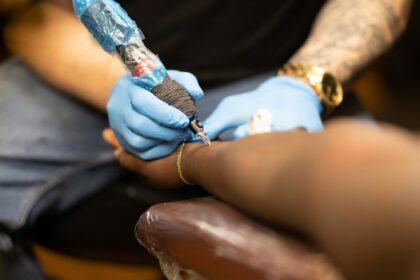In the vibrant world of body art, red ink tattoos have emerged as a captivating choice for those seeking to make a bold and expressive statement. Known for their striking hue and profound symbolism, these tattoos are more than just skin deep; they are a vivid embodiment of passion, strength, and sometimes, defiance. As we delve into the allure of red tattoos, we’ll explore everything from the Meaning of Red Tattoos to the intricacies of Red Ink Tattoo Care. Whether you’re contemplating your first piece of ink or looking to add a splash of crimson to your tattoo collection, understanding the nuances of Red Ink vs. Black Ink Tattoos and the significance of Red Tattoo Ink Allergies is paramount. Join us as we unfold the vibrant tapestry of red ink tattoos, a trend that’s painting the human canvas in the most vivid shades of life.
The Allure of Red Ink Tattoos
The allure of red ink tattoos lies in their bold visual impact and profound aesthetic value. When inked onto the skin, red tattoos are more than mere marks; they are a striking display of artistry and individuality. The vibrant hue of red commands attention, drawing the eye and accentuating the design’s details with its rich, deep tones. Unlike the traditional black or grey, red ink can add a dimension of depth and emotion to a tattoo, making the imagery almost leap off the skin. From the delicate shades of crimson to the dark tones of maroon, each hue carries its own unique vibe, allowing for a versatile range of expression. Whether it’s a minimalist design that whispers subtly or a bold piece that shouts with passion, red ink tattoos offer an unparalleled avenue for self-expression, reflecting the wearer’s personality and aesthetic sensibilities in every stroke.
Symbolism and Cultural Significance of Red Tattoos
Red ink tattoos are steeped in symbolism and cultural significance, making them a powerful tool for storytelling and personal expression. In many cultures, red is a color of contradictions – it represents love and danger, vitality and sacrifice, passion and power. These diverse interpretations make red tattoos profoundly meaningful, with each design often holding a deeply personal significance for the wearer.

In Eastern traditions, red is seen as a symbol of good fortune and prosperity, often used in celebrations and rituals to signify joy and wealth. In contrast, Western cultures have associated red with courage, strength, and the primal life force. Furthermore, indigenous cultures might use red to represent their connection to the earth and their ancestors, making it a color of heritage and pride.
In the realm of red tattoos, each shade and design carries a narrative, a piece of folklore or a personal memory etched in ink. From the crimson rose symbolizing love and beauty to the ruby-red phoenix representing rebirth and transformation, the cultural tapestry of red tattoos is as rich and diverse as the color itself. For the wearer, these tattoos are more than decorative; they are a silent language of the soul, communicating values, beliefs, and stories that transcend time and geography.
Are Red Ink Tattoos Safe?
The safety of red ink tattoos is a topic of significant importance and interest, particularly as the popularity of these vivid tattoos continues to rise. Understanding the components of the ink, potential reactions, and the importance of choosing a reputable artist are all crucial steps in ensuring a safe tattooing experience.
Understanding Red Tattoo Ink Composition and Side Effects of Red Ink
Red tattoo inks are usually composed of various pigments and carriers. The specific pigments can vary, but some common components in red ink include mercury sulfide (cinnabar), cadmium red, iron oxide (rust), or even organic pigments. It’s essential to note that the composition of the ink can significantly influence the risk of allergic reactions or skin sensitivities. In recent years, there has been a shift towards using organic and vegan-friendly pigments to reduce these risks. However, it’s still vital for individuals to discuss the ink’s components with their tattoo artist, and possibly undergo a patch test, especially if they have a history of allergies or sensitive skin.
Potential Allergic Reactions and Sensitivities
While tattooing in general can lead to skin reactions, red ink has been known to cause more allergic reactions compared to other colors. Symptoms of an allergic reaction can include itching, swelling, redness, or the formation of bumps in and around the tattooed area. In some cases, these symptoms might appear immediately after the tattooing process, while in others, they might develop years later. This unpredictability makes it crucial for individuals to be aware of the potential risks and to monitor their tattoos closely for any signs of a reaction.

It’s also worth noting that some red pigments can contain metals like nickel or chromium, which are common allergens. Individuals with sensitivities to these metals should be particularly cautious and consult with their tattoo artist to choose a suitable ink.
To minimize the risk of allergic reactions, it’s advisable to consult with a professional tattoo artist who uses high-quality, reputable ink brands. A good artist will be knowledgeable about the composition of their inks and able to provide information on the likelihood of allergic reactions. They may also offer a patch test, applying a small amount of the ink to the skin to check for any adverse reactions before proceeding with the tattoo.
Increased Risk of Photoreactions
Red ink tattoos may also have an increased risk of photoreactions when exposed to sunlight or certain types of light therapy. Photoreactions occur when the chemicals in the tattoo ink react to light, potentially leading to skin irritation or changes in the tattoo’s appearance. This can manifest as swelling, redness, and discomfort in the tattooed area when exposed to sunlight.
To minimize the risk of photoreactions, individuals with red ink tattoos should be diligent about protecting their tattoos from prolonged sun exposure. This includes using a high-SPF sunscreen over the tattooed area and covering up with clothing when spending extended periods in the sun.
Possibility of MRI Interference
Another potential side effect to consider is the interaction between red tattoo ink and magnetic resonance imaging (MRI) scans. Some red inks contain metals that can react to the MRI’s magnetic field, leading to discomfort or a burning sensation during the scan. In rare cases, the ink can also affect the quality of the MRI image.
While this is generally a minor concern and shouldn’t deter someone from getting a red ink tattoo, it’s a factor worth mentioning to your healthcare provider if you’re scheduled for an MRI. They may take special precautions or advise on the best course of action to minimize any discomfort or interference.
Choosing a Reputable Artist and Studio
The safety of any tattoo, red ink or otherwise, is heavily dependent on the professionalism and standards of the tattoo artist and studio. It’s crucial to choose an artist who is experienced, especially with red ink tattoos, and who prioritizes safety and hygiene. A reputable artist will use high-quality inks, maintain a sterile environment, and follow all health and safety guidelines to minimize the risk of infections or complications.
Before getting a tattoo, it’s advisable to research artists and studios thoroughly, check reviews, and even visit the studio in person to ensure it meets the highest standards of cleanliness and professionalism. A good artist will also be willing to discuss any concerns, provide detailed aftercare instructions, and offer advice on how to care for the tattoo to ensure a safe and satisfactory outcome.
While red ink tattoos can be safe, it’s crucial for individuals to be well-informed about the ink’s composition, potential risks, and the importance of choosing a skilled and reputable artist. By taking these considerations into account, individuals can greatly reduce the risks and enjoy their vibrant red tattoos with peace of mind.
Understanding the Red Ink
Delving into the world of red ink tattoos requires an understanding of the ink’s nuances, from the diverse shades available to the composition of the ink itself. It’s this understanding that ensures not only the beauty of the final tattoo but also its safety and longevity.
Different Shades of Red Ink and Their Composition
Red ink comes in a spectrum of shades, each with its unique composition and impact. The variety ranges from bright, fiery reds to deep, burgundy hues, each capable of creating different aesthetic effects on the skin. The specific shade of red can significantly alter the tattoo’s appearance, with brighter reds often used for bold, eye-catching pieces, and darker reds preferred for more subtle, intricate designs.
The composition of red ink varies based on the pigment used. Traditional red inks were often made with mercury sulfide, known as cinnabar, which gave a vibrant, long-lasting color. However, due to the potential health risks associated with mercury, modern tattoo inks have shifted towards safer, synthetic pigments. These newer pigments are designed to provide the same vivid color without the health risks of traditional ingredients. However, it’s important to note that even modern pigments can vary in quality and safety, making it crucial to understand the specific composition of the ink being used in your tattoo.
Red Ink Tattoo Longevity
The longevity of a red ink tattoo is a primary concern for many, as the vibrancy and clarity of the color are what make these tattoos truly stand out. Understanding how to maintain the brightness of the red and mitigate factors that lead to fading is key to ensuring your tattoo remains as vivid and striking as the day you got it.
Tips on Maintaining the Vibrancy of Red Ink
Maintaining the vibrancy of red ink requires consistent and careful aftercare. Here are some tips to keep your red tattoos looking fresh and bright:
- Follow Proper Aftercare: Immediately after getting your tattoo, follow your artist’s aftercare instructions meticulously. This usually includes keeping the tattoo clean, applying a recommended moisturizer or aftercare ointment, and avoiding picking or scratching the area.
- Protect from the Sun: UV rays are one of the biggest culprits when it comes to tattoo fading. Protect your tattoo from sun exposure by applying a high SPF sunscreen whenever you’re outdoors. Consider wearing protective clothing or keeping the tattoo covered when in direct sunlight for prolonged periods.
- Keep the Skin Hydrated: Well-hydrated skin is crucial for maintaining the vibrancy of a tattoo. Use a fragrance-free, alcohol-free moisturizer to keep the tattooed area and surrounding skin supple and vibrant.
- Avoid Harsh Chemicals: Exposure to chlorine and other harsh chemicals can lead to fading of tattoo ink. Limit your time in pools or hot tubs and rinse your skin with clean water after exposure to chemicals or saltwater.
- Touch-Ups: Over time, even the best-cared-for tattoos can fade. Consult with your tattoo artist about touch-ups if you notice significant fading or color changes in your tattoo.
Factors That Influence the Fading of Red Tattoos and How to Mitigate Them
Several factors can influence the fading of red tattoos, and understanding these can help in taking proactive steps to mitigate them:
- Ink Quality: The quality of the ink used can greatly affect how well a tattoo holds up over time. High-quality inks tend to fade less and maintain their brightness longer. Ensure your tattoo artist uses high-quality, professional-grade ink.
- Skin Depth: The depth at which the ink is deposited in the skin can influence fading. Ink that’s placed too superficially can fade quickly, while ink that’s placed too deeply can lead to blurring. A skilled tattoo artist will know the correct depth to place the ink for optimal longevity.
- Friction and Wear: Areas of the body that experience more friction, wear, and stretching are more prone to tattoo fading. Tattoos on the hands, feet, elbows, and knees, for example, may require more frequent touch-ups.
- Skin Care: How you care for your skin on a daily basis can influence the longevity of your tattoo. Regular moisturizing, gentle cleansing, and avoiding abrasive scrubs or brushes in the tattooed area can help maintain the tattoo’s appearance.
By considering these tips and factors, you can significantly enhance the longevity of your red ink tattoo, ensuring that it remains a vibrant and striking piece of art on your skin for years to come.





